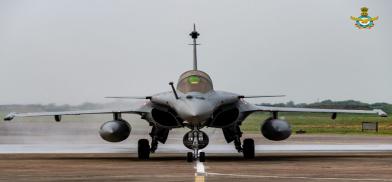Rafale fleet will be a game-changer for India
As the scars of the recent border clash between China and India are still afresh and the tug of war between Pakistan and India over Kashmir continues, security concerns for each nation will continue to rise, writes Megda Bharadwaj for South Asia Monitor

On 29 July 2020, India received the delivery of the much-awaited French fighter jets – Dassault Rafale. The first batch of five jets out of the 36 fighter jets arrived in Ambala marking a historic procurement by the Indian defence ministry. The fighter jets are part of an $8.78 billion deal signed with France in 2016. It is said to revolutionize the combat, offensive and defensive strategies of the Indian Air Force.
The three single-seater and two twin-seater jets with delta wing have been previously used by the French naval and air force, in addition to being also purchased and tested by Qatar and Egypt and has been deemed as omnirole aircraft that can take up several missions on a single flight. It is a 4.5 generation fighter that is somewhat stealthy, though less so than the fifth-generation US F-35. It can carry weapons such as SCALP/Storm shadow which can engage the targets precisely in any weather conditions during day and night and has a range much over 300 km. It can take out targets with extreme accuracy. METEOR, which is a next-generation, active radar-guided, beyond visual range air-to-air missile (BVRAAM) consists of a unique ramjet propulsion system. This ‘ramjet’ motor provides the missile with thrust all the way to target intercept, providing the largest no-escape zone of any air-to-air missile.
This would indicate that it can shoot off Chinese aircraft from a long-range and attack armed military bases within 600 km in Pakistan without crossing the Line of Control or being tracked. Rafale also has the Front Sector Optronics (FSO) system, which is immune to radar jamming while operating in the optronic wavelengths. Several more modifications are being made according to the Indian Air Force standards and needs; including the Israeli helmet-mounted display.
Need for Rafales
The specific features of these jets make them of strategic importance to India and the Indian Air Force and further indicate the growing need for such technology for India. In the past months, the South Asia region, in general, has witnessed growing tensions while India, in particular, has ongoing disputes with Pakistan and witnessed recent border clashes with China. Further, what can be regarded as a significant security threat to India, is the growing presence of China in neighboring countries like the Maldives and Sri Lanka. This procurement of Rafale fighter jets speaks volumes about the increasing security concerns and needs of India, in addition to the much-required reform in the technology adopted by the defense organization.
Comparing it to China’s Chengdu J-20, which is a 5th generation combat jet, Chinese authorities argue that Rafale does not yield a significant qualitative change. Yet, the performance of J-20 is to be seen while that of Rafale has already been witnessed in Afghanistan, Libya, and Mali. Moreover, while the difference and the combat capacity of Pakistan’s F-16 and India’s Rafale are quite similar, the Rafale has been customized according to India’s warfare experience and is nuclear-capable fighter jets which lack in Pakistan’s F-16. This provides it an edge over the adversaries and strengthens the air-power of India which is extremely required under the present circumstances.
India's security dilemma
India has come to become one of the largest importers of arms in the world. There has been an increase in procurement and investment by the Indian authorities in advanced technologies and modern equipment for military and defense purposes. This can be seen as a response to the increasing military capacity of Chinese. Recent years have witnessed an increase in the budget of the Chinese military and has made China the second-largest country in terms of military expenditure. Further, with close ties between Pakistan and China, it has led to a significant development in Pakistan’s military and nuclear weapons program. This increasing the military capacity of its neighbors and the formation of a strong alliance is a classic case of security dilemma which has caused India to take similar actions and increase its security.
Although the phenomenon is a common occurrence in the international order, considering the present situation between India-Pakistan-China, there is a possibility of an increase in border conflicts and expansion by the adversaries. According to Robert Jervis, the Adlai E. Stevenson Professor of International Affairs at Columbia University, "Making an adversary more insecure will often increase its interest in expansion since expansion can often increase security". In other words, the growing need for enhancing one’s security can trigger the adversary to do the same through different means, amongst which one of them is seizing more territories and resources. For India, this would mean higher chances of border disputes with both countries.
The delivery of Rafales was a gamechanger for India. It indicated growth and prosperity not only for the military organization but for the nation in general. Moreover, the delivery of the fighter jets could not be more of perfect timing, giving out a loud and clear message to its adversaries, making this event more symbolic than substantive, amid intensified security concerns in India.
As the scars of the recent border clash between China and India are still afresh and the tug of war between Pakistan and India over Kashmir continues, security concerns for each nation will continue to rise. To seek security, nations have engaged in the process of procuring and developing new military technologies but, in that process, they have set in motion an arms race that is exacerbating.
(The writer is a graduate of Frederick S. Pardee School of Global Studies, Boston, US. The views expressed are personal. She can be contacted at Bharadwaj.megda@gmail.com)









Post a Comment